Skorr
The Skorr are a space-faring, bipedal avian race with what appeared to be feathered wings. They exist as a warrior race with advanced technology and the ability to breed vast armies very quickly. They are native to the Alakaram System and the Planet Skoria.
| Symbol of the Skorr Hierarchy | ||
 | ||
Racial Characteristics[edit]
The Skorr Race is evolved from a species of large avian that eventually took on a more humanoid bipedal shape. They have a pair of functional wings which can reach as far as 20 feet when fully extended wing tip to wing tip. Their feet resemble those of a Terran raptor (avian) in that they are covered with scales and end in three forward and one opposing digit with sharp claws at the ends. They are believed to be very closely related to the Aurelians.
Racial Dimensions[edit]
The Average Skorr is slightly taller than an average Terran, approaching 6’6” to 6’8” for the male of the species, while females measure approximately 5’11” to 6’1” on the average. The average Skorr has approximately the same body width and is nearly twice as light as than their Terran counterpart. The difference in same height, same sex members of the two species can vary between 40 to 60 kg, with the Terran always being the heavier of the two.
The female Skorr is physically identical in outward appearance to the males of the species. Both possess a pair of arms that are identical in form and structure to those of a Terran Human. These limbs possess the same range of motion as those of the Terran species. In addition, they possess a fully functional pair of wings. These wings are easily folded behind the Skorr and are attached to the an additional split shoulder blade. The chest and back musculature in both genders is well defined as a result of constant activity.
The general cranial structure of the Skorr is birdlike in nature. The skull resembles a combination of avian and humanoid features. The Forehead is curved slightly towards the rear. This creates a slight sloping visual effect when viewing the Skorr face. The forehead, although slightly elongated, is not much larger than the Terran normal. Most Terrans relate the cranial structure of the Skorr with that of the Terran Eagle. The cranial structure also possesses a heavy brow ridge which shield the eyes from extreme sunlight at high altitudes. The eyes of the Skorr are identical in appearance to those of Terrans, although each eye socket is slightly larger than that of the average human. The eye structure itself possesses a slightly oversized functional pupil, cornea and lens. This adaptation allows the Skorr to see in lower levels of ambient light, while maintaining excellent distance vision. They possess excellent binocular vision and are reputed to be able to identify small prey at great distances. The “Natural” color of all Skorr eyes is red or copper color.
The Skorr species possesses a pair of hearing membranes to either side of the head. These structures allow the Skorr to detect even the tiniest of sounds. The interior of the structure vibrates whenever sound waves strike it just as a human eardrum does. The acute hearing of the Skorr is capable of detecting sounds slightly above and below the hearing range of the average Terran. The Skorr sense of smell is far inferior to that of a human with the olfactory glands located at the base end of the elongated beak. These glands appear to be similar in structure to those found in most Terran avian species although larger.
The Skorr possesses a strong jaw structure common to aviary animals. This structure extends from an area associated with the bridge of the nose by Terrans out into an extended beak-like structure resembling those of Terran birds of prey, then withdraws into an area commonly seen as the “jaw” by most Terrans. This structure is symmetrical on both the horizontal and vertical axis. The Skorr Species eat only animal flesh and and related animal products. They are know to swallow smooth stones to help them grind their food in their gullets. The gullet of the Skorr also contains a series of serrated hardened knobs of material to further break up food once it enters the body.
Both genders of the Skorr Race possess a fully functional set of bipedal legs and claws. These limbs are similar in structure to those possessed by humans, although the lower portion of the leg is further complicated by the addition of a digigrade joint which is located in the same position as the upper shin of most humans. They are capable of the same range of motion as a Human, and they possess an overall greater physical strength than most Humans as a result of the additional leverage that can be brought to bear. The legs of the Skorr each possess a single foot structure that ends in three heavy toes extending forward and one extending to the rear. These toes resemble those found in the Terran Taxonomy of Terran Avians of the Raptor variety. These digits are composed of three mobile sections and can be used to manipulate very basic grasping needs. The Skorr possess claws, at the end of each toe. As the Skorr species usually have very strong legs, this makes for a potentially dangerous weapon. As for the upper body of the Skorr, they possess a torso, arm and hand structure virtually identical to that of a Terran. They are capable of the same range of motion in these parts, as is a normal Terran. The fingers are just as nimble and capable as those of their Human counterparts.
Members of the Skorr Species possess a series of tail flight feathers ; similar in form to those possessed by Terran flighted birds.
Physiological Notations[edit]
Skorr Physiology is unique in several respects. There are a variety of very useful adaptations that Skorr physiology has managed to integrate and thus ensure their survival.
The main thing that Federation Medical doctors will note is that the bone structure of the Skorr race is very similar to that of humans in the Torso Area. The Torso possesses a series of ribs, a spinal column, a sternum, and scapula almost entirely identical to a Terran. In addition to these basic structures the Skorr also possess an additional split Scapula (shoulder blade) which floats, slightly blow their more traditional scapula and to which their wings are attached. The winds of the Skorr are identical in structure to that of avian species found on most habitable planets. They possess a pair of joined support bones over which is stretched the musculature and flesh that form the wings.
The arm and hand structure is also nearly identical and functions identically to those of an average Terran. The Cranial structure resembles a mix between that of a Terran eagle and a Human being, with structural similarities and characteristics of both. The Jaw structure, while visually and functionally similar to a large number of birds of prey from Earth, also possesses a series of sinal baffles which help a Skorr to differentiate atmospheric pressure. The bones are hollow and exceptionally lightweight, resembling the structure of an avian. This bone is incapable of withstanding heavy shocks and contains the blood producing marrow of the Skorr. As the bones are so light, and tend to fragment when broken, a broken bone is a very serious injury for a member of the species. The healing of such an injury has been known to take several years due to the complications brought on by a result of the bone structure.
The Brain of the Skorr is protected from impact injury by a thin layer of bone that is surrounded by a subcutaneous layer of tissue. This tissue distributes impact forces to counter the effects of shock on the brain.
The interior of the Skorr torso reveals the major organs that they possess. Like humans the Skorr possess lungs, small intestine, large intestine, kidneys, liver, pancreas, appendix, and a heart. Unlike humans the Skorr also possess a muscular grinding organ in place of a stomach called a Gr'rar. This organ helps to further grind up difficult meats that the Skorr species should choose to eat. The Skorr digestive tract very efficient but because of their high metabolic rate they must eat a great deal of meat every day. As a result of this , the average Skorr must eat at least half its body weight in meat and proteins once every 18 hours or they begin to suffer effects of malnutrition. Most Skorr eat every five to six hours, although that frequency is not necessary. The appendix of the Skorr is capable of creating and neutralizing most organic poisons entered into the body. This allows the Skorr race to consume the flesh of some poisonous animals that would normally be harmful to other species. The lungs of the Skorr work exactly like those of a human, although they are larger and stronger than those found in their human counterparts.
The advanced clawed foot, wings and resulting musculature allows the Skorr to leap amazing distances up to 12 meters from a standing position. Due to physical design, Skorr are abhorrent runners, as they are not well designed to handle repetitive impact stress on their leg bones.
Reproductive Data[edit]
Skorr reproduce through copulation, which requires a male and a female of the species to propagate their race. The reproductive cycle is identical to that of most avians. This cycle occurs only once every year and each pair of Skorr can produce approximately 6-8 eggs each breeding cycle. The fertilized eggs require a gestation period of nine months to hatch. After which time the young spend 15 years as young children and adolescents before becoming adults. The parents of the Skorr species are very attentive to the needs of their offspring. Once the young reach the age of 15 years they are drawn into the society as a functional member of the flock. Skorr normally establish consistent breeding mates. Most couples choose to regulate the results of their reproductive cycles through the use of advanced contraceptives. However in times of racial stress, such as war or severe population downturn such as is caused by plague, or natural disasters, Skorr are capable of reproducing in massive numbers.
The Biological Evolution of the Skorr and Aurelian Species[edit]

Among all of the various species of the galaxy, hidden away behind a class G star named Alakaram is a world named Skoria. It is on this world over 1 billion years ago that life emerged. And while we are now aware that the proliferation of life is not a singular event, it is apparently a very precious event.
On the world of Skoria, life began as it did elsewhere throughout the universe; as sludge comprised of simple proteins and single-celled organisms. For millions of years these proteins mutated and composed more and more complex symphonies of life. Eventually communities of similar proteins formed, establishing the first pseudomulti-celled organisms on the planet. These bizarre creatures further specialized to carry on differing functions within the colonies, creating the complex strands that would later become Deoxyribonucleic Acid or DNA.

After almost 200 million years, the first exothermic creatures crawled out of the sludge and stared at the stars and the skies for the first time. These early creatures called Erothropes were incapable of long-term survival away from the pools that spawned them. They were blind, deaf and could only locate food through an acute sense of vibration. The Earliest recorded fossils of Erothropes suggest that the creatures were hardly capable of movement outside of the liquid medium that they were born into. These fossils are not widespread, and so many of the fossils vary within only a few kilometers that Paleontologists believe the Erothrope to be specifically adapted to their particular pool of sludge and slime. These odd creatures were so specialized that the slightest contact with a sludge pool other than their own would be fatal to them. It seemed the interaction between pools was limited to an occasional mixing among pools caused by changes in weather and water patterns. During the formative period that the Erothropes flourished massive changes in the chemical compositions of their pools nearly destroyed them in their entirety. In fact, the species was so nearly destroyed by the primal conditions that the population is believed to have numbered only a few hundred thousand worldwide.
Despite the difficulties Erothropes encountered, they managed to survive and mutate into an organism similar to that of the Terran jellyfish. While still an incredibly simple organism, these new creatures proved more readily able to adapt to the rapid changes of Skoria. The creatures could mingle freely between pools, now beginning to form into large shallow seas and lakes, without worry of poisoning. The new species, named Tetharopes, were quickly the kings of the world that they inhabited. They fed solely on each other, and competition for life in the squalid seas of Skoria was vicious. Tetharopes proved quick to adapt to their surroundings. Clever camouflage techniques, hunting methods and defense mechanisms were developed. It is believed that as many as 300 distinct species of Tetharopes became extinct each day, until finally only the strongest, hardiest animals survived.
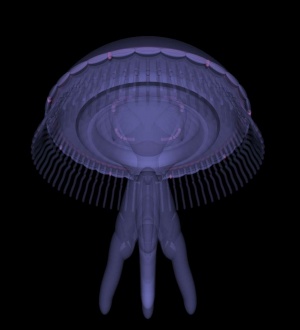
While the Tetharopes were struggling for survival, a new type of organism developed from the complex nucleotides remaining from the previous era. These organisms termed Gargots were the first plant Structures to appear on the planet of Skoria. Gargots were slender, poisonous plants. They are the earliest known species to use photosynthesis on that planet. Gargots were primarily found along the edges of pools, where they siphoned off the precious minerals that they needed for their survival. The hardiest of Gargots eventually developed advanced root systems that allowed them to anchor themselves into the soil and extract the minerals directly from the soil. This relatively new evolutionary advantage allowed the surface of Skoria to be covered by an unheard of number of living species. As the Gargots spread across the face of the world, they mutated to meet the challenging demands of their new environment. After only 50 million years, the Gargot had spread to nearly every comer of the globe and was composed of thousands of distinct subspecies. The table had been set for the rapid spread of life to take place.
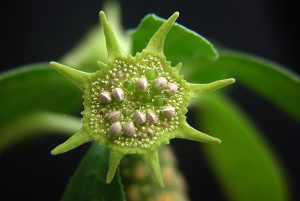
While paleontologists have been unable to completely follow the evolutionary progress of the Tetharopes and the Gargots as completely as they'd like, one thing is certain. Over a period of approximately 100 to 150 million years, Tetharopes developed the ability to breathe air. Along with this remarkable biochemical adjustment they also developed a reliable means of locomotion. Fossils dating from this age are very rare, but almost every fossil from this era shows the distinct development of the flipper. This powerful appendage allowed unparalleled mobility and speed. The design of the flipper was so radical, in fact, that nearly every non-flippered species became extinct within the span of a few millennia. While the Tetharopes were becoming better suited to their environment, the Gargots were doing the same. Roughly 10 million years after their initial appearance on the edges of the sludge pools, Gargots held the undisputed title for the most prolific species of their time. Gargot fossils from this era are the most numerous from any period of Skorr Natural History. These fossils clearly demonstrate the immense diversity that the early Gargot possessed. To date over 300 billion different mutations and subspecies have been positively identified, and it is suspected that this encompasses only 15% of the total likely species that were present during this era.
Historically, somewhere around the period of 600 million years ago, the first truly amphibious creatures emerged from the shallow seas and claimed the solid ground as their birthright. These first creatures were called Aphiopods. The earliest Aphiopods could only remain free from the needed moisture of the seas for a few hours. This was long enough, however, to allow these pioneers to develop a taste for early Gargots. And ironically enough the Gargot would also develop a taste for them.
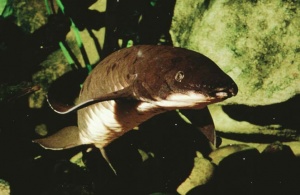
As the Aphiopods became better accustomed to prolonged departure from the seas, they began to develop better defenses against the few Gargots that fed on them. This in tum stimulated the Gargots to develop defenses of their own.
By around 550 million years ago, the first Firapods appeared. These small clumsy animals were the direct descendants of the earliest amphibious creatures. They had disposed of the need to return to the seas and instead began to live their entire life spans on dry land. They primarily ate the course leaves of the early Gargots although a distinct subspecies of Firapods made its first appearance within a matter of millennia. This subspecies was called the Garthropods and were the first effective carnivores on Skoria.
Not long after the appearance of the Garthropods and the Firapods severe changes in climate began to take place. The first of these changes was a direct result of the cooling of the planetary core. The seawaters receded as more of the available water began to be locked up in the arctic ice packs. As the seas receded, the climate and ecosystems that they affected changed as well. New niches were created by this event, and life took full advantage of these alterations. Tectonic activity increased as the continental shelves expanded as they cooled. Massive ranges of mountains and deep gorges divided the continents into various regions. Plant and animal life became more specialized to the ecosystem that they lived in. Life bloomed and grabbed a firm foothold. Life was here to stay.
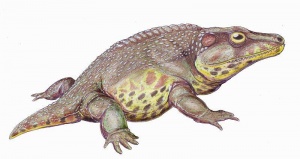
The species known as the Skorr/Aurelian can trace their genetic ancestry back to a small flightless bird known as Pithonarium Psionisium or the "Starget." The Starget was a small bird weighing roughly 5 kilograms. This bird was an excellent hunter, possessing sharp grasping claws and powerful legs. The beaks of this bird were powerful and serrated, allowing the creature to crush bone as effectively as tearing meat. The strong legs of the bird allowed it to climb trees and other natural features quickly, and thus escape predators. But the physical prowess of the bird was not its most amazing feature that distinction belonged to the brain of the animal.
The brain of the Starget was a very complex mass of neurogenic tissue. The animal possessed keen eyesight and probably was reasonably intelligent. The most amazing aspect of the bird was its forebrain, however. The bird possessed a highly developed occipital lobe. While this is not uncommon in sentient beings, the presence in a lower animal life form is rare indeed. The association of the Starget's occipital lobe to the remainder of the forebrain was unique as well. The unique configuration points to the possibility that the small flightless bird actually possessed limited telepathy. While this is supposed, it has never been confirmed, as no living member of the species exist to this present day.
What is well documented, however, is that the Starget evolved into larger and larger flightless birds, until eventually it culminated in the Shargrith or Pitonarium Garithulae. This large bird weighed over 300 kilograms and stood as tall as the average human. Its powerful; beak could slit small trees, and it was every bit a predatory bird. While other Birds took to the sky, the Shargrith hunted larger land animals.
But size had its disadvantages; the Shargrith was nearly driven to extinction as the environment it roamed slowly changed. The Shargrith gave way to a smaller more compact mutation of itself. This mutation was capable of breeding with other avian species, and adopting the various habits and benefits that their diversity allowed for. This species of Bird, the Hartrill, or Pitonarium Garithulae Minimus would soon die out as an independent species, but not before passing its own genetic composition to several competing species.
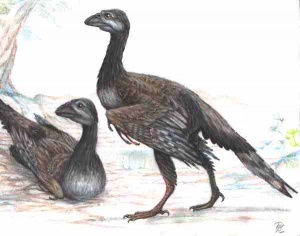
The winner of the evolutionary race on Skoria would be a little known avian species called a Manumit, or Catheria Mamulain, a direct descendant of the Hartrill. This small creature would prove to be the correct mix of genetics, intelligence and mobility needed to rise to dominance on the Skorr home world.
The Manumit was by far the most unlikely creature to rise to the pinnacle of evolutionary perfection. A strange mix of Avian, mammal and reptile, the unusual beast possessed a pair of arms, legs and wings. This unique hexipedal creature would be the forerunner to the Skorr and Aurelian Species. Students of Paleontology argue over the evolutionary pressures that caused this unique creature to undertake such a radical diversion from the generally accepted path of evolution.
In the entire known Alpha Quadrant Only the Skorr and the Aurelians actually evolved wings, arms and legs. The small creature that they originated from used the primitive limbs to climb high into trees. From his newly acquired lofty perch the Manumit would glide down to the ground or to other nearby trees. The creature originally was covered by thick fur, and possessed the warm-blooded aspects of an avian. Only after several hundred years of evolution did the creature eventually develop the strength in its wings to allow for flight. At first, even this was difficult to accomplish, as the skeleton of the Manumit was still quite heavy. As the struggle for survival, brought about by global ecological disaster, became more desperate, the Manumit developed primitive tool using ability. These newly acquired skills would prove to be the decisive edge needed to survive the test of time.
The Manumit evolved over a series of millennia. Each successive generation got smarter and cleverer. The arms and legs lengthened, and the wings compensated for the difference in size. Eventually the body adapted itself towards flight. The bones of the Manumit grew honeycombed and hollow, reducing weight and allowing the creatures to grow bigger. The Manumit also shed its hair-like structures in favor of feathers for aerodynamic reasons. The reptilian ridge that formed the mouth of the beast became extended and hardened. Eventually this structure would become the powerful beak that dominates the Skorr and Aurelian facial features. All of these changes took place over the course of approximately 100 million years; the end result was something completely different.
The Prehistoric Skorr and Aurelians[edit]
The most distant ancestor of the Skorr and Aurelian Species are called the Protoskorr. These primitive creatures developed complex social structures based around an Alpha male of the flock. These flocks were theoretically organized according to the strength of the individual members of the species.
Evidence suggests that these primitive flocks possessed a very complex social structure. Archeological sites in the Farbrinn region of Skoria have uncovered primitive burial pits and archaic cave art. Apparently the Protoskorr were inclined to inhabit large subterranean caverns. Large pits were uncovered that contained the gnawed bones of prey that comprised the Protoskorr diet. Among the findings there are the remains of other Protoskorr. Whether these individuals were members of the same tribe or of other competing tribes is unknown at this time. The diet of the Protoskorr consisted primarily of meat. A large variety of smaller avians were the central staple of their diet. At this period in their history, there is no indication that the Protoskorr possessed the knowledge of fire or tools beyond the most rudimentary tools needed for survival.
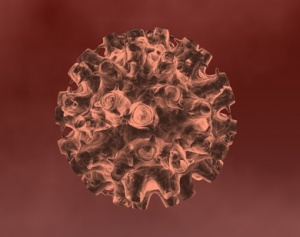
The Physical form of the Protoskorr varied considerably from that of the modern Skorr and Aurelian. The Protoskorr possessed a smaller, less intimidating beak. The beak was specialized to rend flesh rather than allow a more diverse diet, as is the case with the modem Skorr and Aurelian species. The feathers were coarse and colorless, primarily various shades of gray. This is evidenced by the vast number of petrified feathers that have been recovered from this era in Skorr/Aurelian History. The spine of the Protoskorr was shorter and curved in such a manner as to force the Protoskorr into a crouched position. This may have been a direct result of nesting choices. The choice of nesting inside of caverns created a sense of confinement that may have unwittingly forced this unique environmental adaptation. This theory holds true, when you compare later, farther evolved Skorr with the Protoskorr. As the latter species of Skorr do not possess this curved spine and do not nest in subterranean caverns, it is supposed that the unique curved spine is indeed a product of environmental evolution.
The species population of the Protoskorr numbered roughly in the hundreds of thousands. A relatively high birth rate and surprisingly low death rate allowed the quick propagation of the species. But a greater threat would make itself known in the years to come and drive almost the entire species to the brink of extinction.
Roughly around 300 million years ago, a new predator was seen for the first time on Skoria. This predator was efficient, deadly and ruthless. It is expected that it is solely responsible for wiping out the majority of the planet's species within a few centuries. What was this terrible new beast? Disease- that unlike the viruses on other worlds had developed several millions of years before the first multi-cellular organisms- was a relatively new species on Skoria. Viruses ran rampant among the various species on the planet. The weak and strong were slaughtered without mercy. Entire species succumbed to the legacy of extinction, among them many of the key species that the Protoskorr hunted for food. The Protoskorr were driven nearly to the point of extinction, and then a miracle occurred.
A few communities of Protoskorr had migrated out of the caves and caverns that they had been nesting in for thousands of years and they stopped dying of sickness. Scientists attribute this rapid spread of disease to the improper sanitation techniques and the primitive burial procedures that the Protoskorr had adopted. When they removed themselves from the cesspools full of disease and sickness and adopted better burial techniques, the primary source of disease was removed from their immediate proximity. Eventually the Protoskorr developed an immune system that allowed them to combat the various plagues and viruses that ravaged their world. And over the course of a few generations, their backs straightened out and their diets began to change. Within a few hundred years they would be barely recognizable as members of the same genetic stock as their Protoskorr ancestors.
Eventually advances in technology allowed the new species of Skorr/Aurelian to formulate larger and better-organized flocks. The newest species of Skorr/Aurelians were known as the Anteoskorr. It was during the period that the Anteoskorr lived that the first signs of civilization are confirmed. While still a relatively primitive species, the Anteoskorr developed domestication and agriculture over the span of roughly 200 years. This discovery allowed the Anteoskorr to develop primitive territorial boundaries.
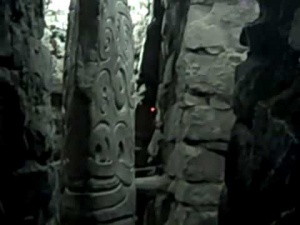
These boundaries, in turn, led to a more organized social and pseudo-political structure. Burial rituals of the Anteoskorr became more elaborate, and the earliest evidence of the belief in an afterlife is seen for the first time in this era.
Archeological sites in various regions reveal a strong social bond around a centralized community fire. Large fire pits dominated the Anteoskorr community. The general impression that is made concerns the social gathering of the community together to divide up the bounty of the harvest and to cook and consume wild game. Although this social interaction was limited, it is believed that the development of advanced linguistics began to develop around this time. While it is a general belief that civilization cannot be founded without language that does not indicate a complex linguistic structure.
Demonstration and simple descriptive phrases can be used in place of a more complicated language to convey ideas and meaning to other members of a community. Storytelling, which almost always develops as a form of social entertainment, however requires a larger and general more complex linguistic base to convey immaterial concepts and thoughts. Since storytelling is a basic concept of communication that develops from a social environment, it stands to reason that the social development of community activities would stimulate and force the expansion of linguistic capability. While the types of stories and informational discussions are unknown, it can be said that a fair amount of scientific exploration and primitive social developmental skills were directly impacted by the development of this linguistic expansion. For a species already extremely social by nature, this critical sharing of ideas and philosophical concepts helped to uniformly shape the direction of Anteoskorr society.
To demonstrate this principle more thoroughly; the Anteoskorr showed rapid development in the areas of agriculture and architecture. The likelihood that the degree of expansion that is shown would develop within a confined geographical area within decades is extremely unlikely. This assertion becomes even more preposterous when evidence of architectural design is present in not one, but thirty different regions, each maintaining only slightly different designs. And these design differences are so minor that they are virtually replicas of the other structures found-the only alterations made are seen to be functional requirements placed upon them by their direct ecological regions.
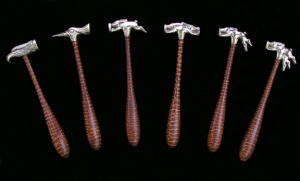
Over the period of several hundred generations the Anteoskorr evolved ever slowly towards the genetic perfection that was to be the modern Skorr and Aurelian species. The new species was taller, stronger and faster than their ancestors were. They were better adapted to consuming a more omnivorous diet.
While the Anteoskorr had little, if any interest in artistic expression, the newer species showed an inclination to create elaborate artistic shrines. The new species were socially more complex and technologically adept. Through the pressures of social change and technological superiority, these new Skorr/Aurelians, the Eremaskorr would develop the basis of modem Skorr/Aurelian Society.
The first contribution that is attributed to the early Eremaskorr is the development of an organized governmental system. This is a grossly inaccurate statement. While the debate over which ancestor of the modern Skorr developed governmental organization continues, take the time to consider a few points.
First, the creation of any social order requires a leadership to be established. Studies have shown that even in a social situation where no uniform structure exists initially, a leadership position will be formed and social order will be established. Second, The establishment of a leadership structure is indeed a form of government. This can be demonstrated by defining the purpose of government. Social Scientists have long determined that government is The social organization required to maintain order and ensure the needs of a large social group are met. These needs include food, shelter and protection and are administered or regulated by the establishment of any governmental body. While the influence of government is not always apparent in these things, government must be present for these needs to be filled on a scale above that of a few individuals Third, if these previous two steps are seen as true, then Government among any species dates back to the earliest formation of tribal communities. And since this is the case it is safer to state that the Eremaskorr was not responsible for the creation of governmental structure, but rather for the creation of the Bureaucratic Structure that is commonly mislabeled as government.
The Eremaskorr indeed were the masters of their worlds. Under their social and linguistic leadership, architecture and agriculture prospered. Irrigation and large social meeting halls were built for the very first time. The first metropolis was constructed during a period of 2,000 years. This massive city spread across an area of 6 square kilometers. Tarimirithia was the greatest wonder of the ancient world.
Massive terraced gardens surrounded the city. Some of these terraced structures rose hundreds of meters into the air. Massive public works supplied the city with water. Large common areas held marketplaces and festivals. But most importantly, the very first organized civilization bearing a political affiliation was established here. The effort of organizing and undertaking these massive projects must have been monumental themselves. Bureaucracy was developed to manage these projects and to ensure that workers would not starve during construction.
And with bureaucracy came literacy. The Eremaskorr were masters of the written word. For the first time in the history of the Skorr/Aurelians we see characteristic linguistics that are most definitely language. The earliest records that the Eremaskorr kept were carved into the shafts of feathers. These shafts were then dipped into a dye. The dye would settle into the carved recesses but run off of the unmarred exteriors of the shafts. The result was rich characters contrasted by the exterior of the shaft. It is suspected that this bizarre medium for communication was chosen for its low weight. Since Eremaskorr messengers would be required to fly an unknown number of kilometers, it makes a great deal of sense to keep the message as light as possible. Another point to be mentioned is that the knowledge of chemistry was still unknown to the Eremaskorr. Thus, although they had a plentiful resource of cellulose material from which paper could be made, they did not possess the knowledge of the process. Where their apparent lack of knowledge in physical sciences was a hindrance to the Eremaskorr, their extensive knowledge of mathematics and architecture was by far an advantage.
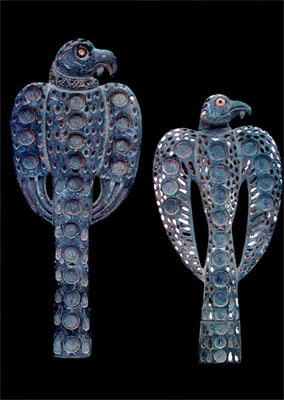
New evidence suggests that the Eremaskorr also had a keen interest in Astronomy. This theory is supported by the precise orientation that their major architectural structures possess. Each major structure is perfectly aligned with the rising of the summer sun. While this is not unique among ancient civilizations, it does show an advanced mathematical aptitude and a distinct interest in the universe that they inhabited.
Where the Eremaskorr were the engineering geniuses of the ancient Skorr world and responsible for the proliferation of ideas and science, they are not the species that was the mainstay of the evolutionary cycle on Skoria. That distinction belonged to the Neoroskorr.
The Neoroskorr were originally an offshoot if the Eremaskorr and like their predecessors they were organized in tight social groups. A major difference in this new species was in breeding habits. While the Eremaskorr were geographically capable of breeding with other tribes of their species, they apparently did not do so often. The result of this generational inbreeding was genetic death. Eventually birth defects and genetic disease began to take their toll. The few tribes that did practice intertribal breeding matured genetically. Some developed early telpathy and other psionic gifts as a result of strong genetic codes; others grew stronger, faster and smarter as a result of their intertribal genetic exchanges. The results of the intertribal breeding resulted in the Neoroskorr being the closest ancestor to the modern Skorr. With the decline of the Eremaskorr the Neoroskorr were easily perched to assume the control of the genetic monarchy.
It is estimated that the Neoroskorr species numbered only in the thousands when they assumed their place in the genetic history books. With the last of their predecessors dead, it looked as if the Neoroskorr would suffer the same genetic death that befell the Eremaskorr. But a slight genetic glitch, actually a defect saved them from that fate. A pair of Chromosomes within the Neoroskorr species simply refused to bond as they were supposed too. A visible result of this was the sudden color that appeared in the feathers of the Neoroskorr. The genetic implications, however, were much more advantageous. This chromosome pair called pair 943a/943b had the bizarre habit of linking to other already mated pairs of chromosomes. This haphazard linking was not limited to a certain pair of linked chromosomes, but instead seemed to occur randomly. This created nearly infinite genetic diversity, which in turn, prevented the genetic decay of the species. To make matters even more confusing, 943a/b sometimes were not present in the offspring of parents that possessed the 943a1b chromosomes. While the assumption is that 943 a/b were responsible for the sudden coloration of the Neoroskorr can be proven, the absence of the chromosomes do not make an individual Skorr devoid of colors. This sole distinction is the primary difference between the Neoroskorr and the Eremaskorr.
Apparently no love was lost between the Eremaskorr and the newer species. A cultural backslide took place. The pinnacle of technology and social order degenerated and the great city of Tarimirithia was abandoned. For all of their genetic superiority the Neoroskorr were reduced back to a technological level associated with the Stone Age. It wasn't until another major genetic shift took place, nearly 100 million years later that the civilization would recover their lost technology and truly form a civilization that would span the globe.
The Neoroskorr would establish villages and roosts. They would continue to cultivate plants and domesticate animals. They would make some advances in metallurgy, discovering copper, bronze and iron.
They would organize themselves into primitive tribal governments and sociological groups, but most importantly-they would evolve.

To say that technological advancement was slow on Skoria is not a fair statement to make. The truth of the matter is more the need of necessity rather than intelligence. The various species developed as quickly as they needed to advance. They developed sciences and skills that they required ensuring their survival to be certain. They simply did not develop related technologies that they had no immediate use for as quickly. A definitive example of this is seen by the distinct lack of roads and alternate transportation. It isn't that the technology was beyond the various civilizations; just that it was unnecessary. The Skorr are avian creatures and as such could move faster and more directly from point to point then they could by way of road. The hard work required to build roads wasn't worth the effort until the development of trade and mass transportation. Thus, while bipedal creatures developed the road early in their civilizations, the Skorr and their ancestors did not do so until very recently [as time flows].
The evolution of the Neoroskorr would not be a major overhaul in appearance or physical structure; instead it would be a change of mind. Roughly 20 million years ago the Neoroskorr began to develop more and more Psionic abilities. This continued until gradually the actual genetic code of the species differed form the original code of the Neoroskorr. The same genetic gift that allowed the Skorr to develop these psionic abilities also caused another genetic anomaly, genetic insanity. Through the slow mutation of Chromosome 943a/b the mental capacity of the Neoroskorr increased, as did the ability of the Neoroskorr to withstand extremes of emotional stress. While some geneticists argue that the trade was more than fair, others see the mutation as a natural way to prevent the Neoroskorr species from overtaxing their delicate environment.
The New species that evolved from the Neoroskorr was the Ideaoskorr and is the most advanced genetic descendant of the species on Skoria. It is important to note here for the reader that the Aurelian species is not a member of the Ideaoskorr as they have undergone enough genetic evolution to now be considered their own species. The author at this time wishes to make it clear that he possesses no opinion of genetic superiority when comparing the two species. Also the author will refer to the Skorr and Aurelians prior to the separation as theSkorr; post separation, a distinction will be made, in which the Skorr will be called as such and Aurelian will signify the Aurelians.
Skorr History[edit]
The Skorr race possesses a rich and vibrant history filled with warfare, near ecological destruction, marvelous artistic ages and periods of rapid technological advances. As a race the Skorr are naturally willing to accept other cultures, beliefs and points-of-view, although they instinctively distrust non-carnivorous species. The Skorr people possess a great deal of patience as a whole and naturally make excellent warriors and diplomats. Skorr culture is carefully organized around the tribal organizations that developed on their home world. This organization is present throughout their history and cultural identity. As a culture they are rich in Literature, Sculpture and Poetry. They also highly value Martial Skills.
The Skorr Timescale[edit]
The Skorr Timescale revolves around the changing seasons of their home world. Because of a racial tendency to be semi-nomadic, Skorr are always willing to travel to new places and experience new things. Although a patient peoples, the Skorr species seems always to be hunting. This is a direct result of their evolutionary development, caused by their heightened awareness of potential prey caused by their predatory instincts. The Timescale reveals some of these qualities during times when the periods of histories were bloody or violent. The entire history of the race is taught to each member of the species, and is often recited by word-of-mouth. The times when there were rapid sequences of events taken place are traditionally spoken as quickly as possible, to dictate the chaos of the times. Every member of the race also memorizes the Genealogies of the Royal Lineage along with their great achievements or failures. Every member of the species must be able to recite this information upon request, and this is sometimes done in formal meetings.
Skorr Ages[edit]
Skorr scholars use the term ages much in the same manner that Human scholars do. They represent a general period of history where a uniform social, economic, political, or technological condition was present. These ages may span through any number of years or members of the Royal line, or they may be isolated to a single sequence as history dictates. If more than one-age shares common conditions then usually those ages are named the same, although they are numbered sequentially, in the order that they occurred. Thus the First Golden Age and the Second Golden age are similar enough to have very similar characteristics, although the first golden age occurred first chronologically.
Major Events in Skorr History[edit]
In the history of the Skorr home world there are records of individual wars, followed by confederations fighting other similar confederations, and then finally a unified planetary governing body, the present Skorr Hierarchy.
Also present in the history of the Skorr people is the lean times, a period of near ecological extinction that almost destroyed all life on the planet. Only the development of ecological awareness and reclamation science allowed the continued existence of life on the planet.
The individual that finally brought an end to all the fighting was Alar, the first member of the current Ruling house of the Skorr Hierarchy. Alar preached peace and unity and began the Martial Religious Movement that later became the basis for the Skorr System of Honorable Deeds. He used a recently discovered Alien artifact, which he dubbed the Soul of Skorr to unify the people. This device has some amazing properties and is considered the most valued treasure of the Skorr people.
Alar's offspring have maintained their famous predecessor's legacy and maintained a unified and well run society. All members of the Skorr Royal Line possess a rare blood type that makes them readily identifiable by medical scanners, preventing pretenders and usurpers. The Senior generational Member of Alar's line is the High King of the hierarchy and must be a direct descendant to rule.
First Contact with the United Federation of Planets[edit]
The Skorr first contact with the federation was not without incident. In 2245, the Federation Starship Olympiad, NCC-0300, A Soyuz class starship, entered the Skorr star system on a standard surveying mission when it was attacked and destroyed by Skorr warships. The Federation Starship, Grendel, NCC-2033, a Constitution Class starship, was also destroyed after attempting to locate the lost Olympiad. After the loss of the two starships, Starfleet command suspected the Klingons or the Romulans, and decided to dispatch the USS Laredo, USS Montana, and the USS Johannesburg to investigate the situation. Upon the arrival of the three starships into Skorr space, the Skorr fleet set them upon. After several minutes of intense conflict the three Federation starships withdrew. There was no other contact with the Skorr species until 2269.

In that year, the USS Enterprise commanded by Captain James T. Kirk was dispatched to Skorr Space, when Starfleet command received an ultimatum to "...Return the Soul of Skorr or face the consequences." Faced with the possibility of a war with an enemy that they did not know or understand, the Enterprise crew eventually unmasked the culprit behind the theft and healed the relations between the Skorr Hierarchy and the UFP.
Prior to their disastrous encounter with the UFP, the Skorr had developed a warp 9 engine, although they lacked communications and computer technology to utilize it fully. Skorr government programs managed to retro engineer several of the primary components of the Federation starships destroyed in those critical first encounters and began a serious warp space program of their own, now that they possessed subspace communications and advanced computers. After developing an orbital space-manufacturing shipyard they built their first truly advanced warp vessel. This first vessel, the Moonlight Stalker, was later responsible for the signing of the peace treaty between the Federation and the Skorr Species. This state of War was unknown to the UFP until the establishment of the official contact with the Skorr species in 2269. It was during these historic peace accords that it was discovered that the Skorr starships that had encountered the USS Olympiad and the USS Grendel in 2245 were not equipped with communications technology, and that said technology wasn’t developed by the Skorr Species until after the battle with the USS Laredo Task force. The attack was prompted by the detection of subspace radio waves that were misidentified as an advanced weapon of some sort. These radio waves were, in fact, the hails of the Federation starships.
In 2380, after nearly 111 years of peaceful relations the Skorr Hierarchy joined the UFP in a technology and trade agreement and very limited military alliance.
Skorr Government[edit]
The Government of the Skorr people consists of 4 layers. At the local Level there is the Hirad'ja, overseen by the Prince. On the next Tier up there is the Mar'kaj overseen by the High Prince. Directly above the Regional level, is the Skorrjia, which is headed by the Crown Prince. Overseeing all levels of government, concerning the Skorr people as a whole is the High King.
The Hirad'ja[edit]
At the local level of Skorr government is the Mayoral Level or Hirad'ja. The Hirad'ja is comprised of all of the persons living inside a specified urban region, usually that of a single urban area, or sparcly populated colonial district. These positions, as with all governing positions inside the government are held by the members of the royal Line of Alar. In the case of the Hirad'ja, these members are distant relatives, whose blood line has been diluted through intermarriage with other bloodlines, or those who are far down in the succession for the position of the High King. Those appointed to this position is subject to change should the Ruling High King be replaced.
The Mar'kaj[edit]
At the regional level of the Skorr government is the Regional level or Mar'kaj . The Mar'kaj consists of all of the members living inside of a specified region, usually that of a district or state sized political region. All densely populated Skorr worlds are divided into 15 Mar'kaj districts. These districts are not assigned until the planet in question reaches a predetermined population minimum, until such time as that happens, a planet with a population lower that that determined is considered to be a Hirad'ja. Each Mar'kaj is ruled by a High Prince. A High Prince is within a few generations of the throne, although there can be numerous High Princes. They are usually considered the middle generations of the ruling High King. Those appointed to this position are subject to change should the Ruling high King be replaced.
The Skorrjia[edit]
At the Global Level of the Skorr Home world is the Skorrjia. The Skorrjia consists of every member of the species living on Skoria. All other Skorr Worlds have no Skorrjia leadership, as they are considered colonies of Skoria and fall under the jurisdiction of the Skorrjia. They represent themselves in a council of the Mar'kaj which is considered an office of the Skorrjia. The Skorrjia is overseen by the Crown Prince, who is the next in succession to replace the High King.
The High Throne[edit]
There is only one High King, and he is the ultimate law. Currently this position is held by High King Kamuth. The High King has the complete and total authority over every aspect of Skorr life. He has the ability and authority to run any level of government and holds the sole authority for dealing with non-Skorr Species. The High king is advised by a sect of Religious advisers, who maintain the traditions and ideologies of Alar. They are the keepers of the Soul of Skorr, which is said to contain the consciousness and combined life experiences of not only Alar but of every prior High King. The High King is the only member of the Skorr Species entitled to directly merge with the Soul of Skorr. However, there have been exceptions made, with the High King's permission for other members of the Royal Family to have their collective experiences added to the Soul of Skorr for the benefit of the King's advice.
[edit]
The Skorr possess a formidable Fleet, which consists of a large number of starships and personnel. Due to their limited Military Alliance with the UFP, they respect Starfleet rank equating it with a rank equivalent in their own fleet. The Skorr Military is responsible for all levels of military activity, including space combat as well as planetary actions and occupational roles as needed.
Other Governmental Offices[edit]
The Princes can not be everywhere at once, nor can they maintain every aspect of their charges without the assistance of other members. Each of the Princes have the authority to can create or absolve any office, position or function of the government at their appropriate level as they see fit. They have the power to assign individual members of their population to governmental, social, or cultural positions within their respective regions as they see fit for the betterment of the region that they rule. These other offices vary wildly from region to region.
Skorr Technology[edit]
The Skorr People are adept at adapting and developing any military technologies that they have the opportunity to study. This comes from a strong racial understanding and connection to their martial nature.
Most non-military Skorr Technology is geared toward maintaining their planetary ecosystem. This consists of advanced hydroponics and terraforming technologies and is coupled with advanced energy and food production systems.
Skorr Mass Transportation Systems are comprised of clean electromagnetic propulsion. With a electromagnetic hovercraft vehicles commonly used to move goods. These drives produce no harmful pollution while allowing a reasonable means of transportation. The Skorr People have also developed clean fuels and power supplies for use in alternate systems.
The highlight of Skorr Technology is their Social Engineering. They have developed advanced limited resource reclamation techniques; these techniques are applied toward mining and agricultural mediums as well. The Primary example of this social engineering is the creation of massive irrigation projects to maintain specific environments.
Skorr Starship Technology is roughly fifty years ahead of that used by the Federation. Their primary weapons design is based on phased plasma technology.
Skorr Culture[edit]
Skorr People are very artistic and pleasant to spend time with. They have a tendency to become attached to those around them and willing to defend them to the death if necessary. The Skorr people make a big show of holidays on every scale. Birthdays and Anniversaries are always largely shared events. Equinoxes and Solstices are usually celebrated by Skorr people, to commemorate friendships, renew oaths, pacts and agreements. The Skorr have a wonderful sense of Culture as a race. They exalt art of all sorts, especially martial ones oriented around the bow or spear, while maintaining intricate works, such as glass blowing. They also love a wide variety of music, and every City on the home world has at least 3 famous museums or auditoriums. Storytellers and playwrights are among the most respected members of the race, with musicians and Artists ranking a close second. Architecture is considered an art form, and most major cities contain several phenomenal structures to behold. A Skorr as a general rule will rarely choose not to express themselves in some form of artistic manner, most choosing music or acting.
Because of their own rich culture, the average Skorr often chooses to embrace other cultures artistic heritage openly. This acceptance of foreign culture by the Skorr People has often resulted in a strong tie between an individual Skorr and shipmates or co-workers. The Average Skorr is open to new experiences and individuals. They rarely choose to abstain from participating in activities or work-related tasks. They are careful to always find good in the activities and expressions of others before pointing out obvious flaws they may contain. Because of this it is supposed that the Average Skorr would serve well on most federation starships.
The Soul of Skorr[edit]
| Soul of Skorr Replica | ||
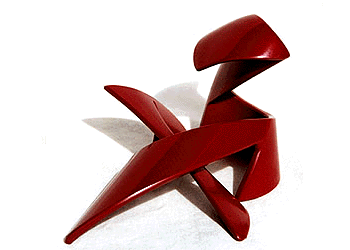 | ||
Soul of Skorr was an extra-dimensional object that was attuned to the unique lineage of Alar. As such distance is irrelevant to it. Any Skorr attuned to the artifact is capable of depositing their memories into the device once they had achieved the necessary mental state, although only the High King can retrieve any memories so stored there.
Only the High King knows the origins of the device, since only he can see the wisdom and memories of Alar; the first Skorr to use the device. There are speculations of course. They range from being an alien artifact found by Alar to a gift from the Ancient gods of the Skorr people. In any case, the artifact is said to protect the collected knowledge of the royal lineage and also to protect the Skorr People. How exactly that would be done was unknown, but within Skorr Society it is believed beyond all other things. It truly is considered the Soul of all that the Skorr people are.
There are only replicas on display across the Skorr Hierarchy. The actual artifact is such a valued item that only the High King and a handful of attendant priests know of it's location. Even Dralar, a member of the royal line would never know where the Soul was kept unless, by some twist of fate, he became the High King.
A replica of the Soul of Skorr rested in the outstretched hands of the Statue of Alar, located in one of the most sacred places in Skorr Culture; the great Temple of the Sky at Mozna Amar.
The True Soul of Skorr, is a knot of unique materials that has been identified as indurite. The material in some manner bends time, space and dimensions. It was such an amazing thing that even to this day, no Skorr Scientist or priest understands how it works. They only know that it does.
The Temple of the Sky[edit]
The primary religious center for the teachings of Alar. the Great Temple of the Sky at Mozna Amar is the most sacred places in Skorr Culture.
The temple itself is situated atop a great mountain top that had been leveled in ancient times. The mountain is known as Kelja or "The place where the world meets the Sky" In the later days of Alar, the Skorr people removed and flattened the last 300 meters of the stone mountain top. On that plateau the ancient temple had been built.
The structures were made entirely of the stone taken from the top of the mountain. Each hand carved over the millennium by master craftsmen.
| Temple of the Sky | ||
 | ||
The busts of the descendants of Alar, all High Kings throughout the ages lined a broad avenue flanked by stone pillars decorated with gold leaf and intricately etched into beautiful abstract patterns.
At the end of the long avenue of colonnades was the temple building. An Acropolis like structure ringed with more columns reminiscent of those found on earth during the Greco-Roman period. Large lintel pieces spanned the columns and their carvings were enhanced with precious metals and jewels. They represented the life of Alar, the single most important figure in Skorr history. It was his wisdom that united the once warring clans of the Skorr people into a single purpose. It was his legacy that turned the Skorr into a star faring people. It was his desire and teachings that allowed them to reach out to other species with peace and understanding without sacrificing their strong martial traditions.
At the end of the Avenue there are wide steps, purposely designed to be uncomfortable to Skorr physiology. Visiting Skorr are not permitted to use their wings to aid them when climbing these stairs. These were the only steps found anywhere on the planet and they were here to remind the royal family of humility.
At the top of the steps there is a broad open area of the temple where a group of priest wait for Royal visitors. In that open space a replica of the Soul of Skorr rests in the outstretched hands of the Statue of Alar. A representation of his gift to the Skorr people.
The Ritual of Ahk'kan[edit]
The ritual of Ahk'kan is a religious ceremony presided over by the High Priests charged with the welfare of the Soul of Skorr. The ritual can only be performed upon a member of the Skorr species who is a direct descendant of Alar. On Stardate 2407.07.04, Dralar the 45th Prince of Skoria undertook the ritual. below are excerpts showing the stages of the ritual.
Dralar was wearing his full regalia as was befitting a Skorr of his stature.
The uniform was a rich orange and gold and was made of a fabric the allowed the light to cause the colors to appear to shimmer as it reacted with the fabric. The symbolism of the colors was that of Sunset. The ending of the day just as there could be a potential ending to Dralar's life in the coming days of the battle.
He wore his princely Brocade that clearly announced his heritage to the trained eye. His badges of office and right of lineage were pinned to his breast for all to see. His foot talons were tipped with Golden caps, a ceremonial version of the claw blades that his people still wore into battle. Rich elaborate ribbons made of the same material as his formal attire wrapped around his lower legs below the feather line.
His royal feather crown had been coated with a light dusting of gold and orange fleck. The only special indicator of his lineage. Even if he were complete stripped of all other affairs of state, his head feathers would immediately identify him as a member of the royal lineage. It was a genetic disposition that only the members of his bloodline carried. It had been that way for millennium and dated back to the time of Alar the greatest member of their people. He was first High King and savior of the Skorr species. It was his collected wisdom as well as that of every member of the Royal lineage that resided inside the Soul of Skorr. It in turn was accessible only to the High King of Skoria. In this manner all experiences and knowledge could be saved and reviewed as needed for Generations to come.
That was why he was here. To ensure that his memories would not be lost.
It had been explained to him as a child that the Soul of Skorr was an extra-dimensional object that was attuned to his particular lineage. As such distance was irrelevant to it. Any Skorr attuned to the artifact could deposit their memories into the device once they had achieved the necessary state, although only the high King could retrieve any memories so stored there.
The scene was one of the most sacred places in Skorr Culture; the great Temple of the Sky at Mozna Amar.
Dralar strode up the long avenue facing each of the 600 Skorr High Kings, his ancestors and reciting their names in turn. Once that was finished, he strode up the wide steps, purposely designed to be uncomfortable to Skorr physiology. He climbed them slowly and with difficulty. He understood well enough that he was not permitted to use his wings to aid him. These were the only steps found anywhere on the planet and they were here to remind the royal family of humility.
Once he had defeated the steps he moved into the broad open area of the temple where a group of priest stood waiting for him.
"Halt, Skorr Prince." The voice of the high priest commanded, and Dralar stopped were he was.
"Since the times of the ancients, Alar has given us his wisdom. Why do you now come to this, our most sacred place?"
"I come to impart my experience to the Soul of Skorr, that all those of my lineage shall know of my deeds and my experiences. I come to deposit my Ahk'kan so that in the coming days my contribution to my people shall not be lost." he replied.
The priest regarded him down the length of his long jagged beak.
"What do you have to contribute that shall be stored for all time, prince of Skoria?"
I have intimate knowledge of our Allies, great priest. I have seen things that shows that there are those among the stars that we should count among our friends. I wish to share their struggle so that the people of Skoria shall understand their plight and our role in the galaxy. I serve the blood of Alar and I serve the Skorr people. I seek no glory nor self aggrandizement. I seek only to impart my experiences so that our people do not lose them for all eternity as was the way before the time of Alar. Should you deem that I am deceitful in this, may you shatter my wings and throw me from this high place so that my spirit will forever walk the world unable to ride the winds for all eternity."
"You must show that your desire is pure." the priest replied. "You shall now partake of the Misact Essence and prove that your heritage is true."
Dralar nodded.
A second group of priests came forward bearing a gold box. In it was a vial of poison. This was the only aspect of the ritual that was not replicated. It was the actual elixir that his people used in this very ritual.
Dralar knew from experience that the poison was painful, as it would attack the pain receptors throughout his body. He also knew that the same genetic disposition that made him a prince of Skoria would not allow the poison to kill him. It would be excruciating, but he would not die.
This part of the ritual was designed to ensure that no impostor could ever influence the Soul of Skorr for personal gain.
The golden box was opened and a junior priest removed the crystal vial from the container.
He held it out to Dralar. A second junior priest removed the cut crystal stopper.
Dralar reached out and took the bottle in his right hand.
"Recite the words." The high priest ordered.
I am Dralar 45th Prince of Skoria, Keeper of the Great Sky Key of Harridan. I trace my lineage back through the ages calling all of my ancestors to recognize my worth. I descend from the blood of Alar and declare my heritage pure. Should I be deceitful, may the poison of the Misact claim my pathetic life and may my name be forever stricken from the history of the Skorr peoples and all my descendants made outcasts for all time."
"You may prove your worth, Dralar, 45th Prince of Skoria for all to bear witness here." The priest intoned.
Dralar turned up the small crystal bottle, emptying his contents down his gullet. As expected the pain started immediately as the poison went to work.
It began as a knotting and cramping of muscles deep in his body The pain and convulsions followed soon after and his feathers shook with spasms as the muscles at the base of the feathers began to spasm. Dralar doubled over as a cry of pure agony escaped from his beak. He lost his balance and pitched forward. The priests did not move to aid him. He rested on his hands and knees as the poison coursed through his body, sending wave after wave of unimaginable pain through him.
His body reacted. Glands in his body began pouring a hormone unique to his bloodline into his body before the poison could stop his heart or make it impossible to breath.
Slowly the pain and spasms receded. After a short time, Dralar pulled himself back to his feet. He straightened his formal attire and held his head high.
"I have shown my lineage to be true and pure. I claim as my right the ritual of the Ahk'kan transfer, that my contribution to my people not be lost or forgotten. I call on you now priest and keepers of the Soul of Skoria to grant me my blood right."
The priest looked down at Dralar.
"Come great prince and give your contribution to the greatness of your people. Your knowledge shall become one with the Soul of Skorr that you shall never be forgotten and your knowledge shall be always there to guide the High King in his stewardship of the Skorr race."
Dralar moved forward to the stand before the outstretched hands of the statue of Alar.
The three attendant priests moved forward surrounding him. The eldest priest spoke directly to the statue of Alar.
"Our great ancestor, most beloved and celebrated of our peoples. I present before you Dralar, of your lineage. The 45th Prince of Skoria and Keeper of the Great Sky Key of Harridan. He claims the blood right of the Ahk'kan transfer, that his contributions may be used for the benevolence of the Skorr people and that his experiences not be forgotten."
"Alar, grant his request," all three Priests repeated simultaneously.
Dralar's body suddenly went rigid as he felt the presence of the Soul of Skorr come over him. He had experienced it before and still found it an amazing experience. He was in a state of sublime ecstasy as the Soul overcame him. He knew that his entire life was being recorded, and that the process of recording would continue for several standard weeks, or until he died whichever came first. Only at this very moment, when the soul accessed his entire history would he be aware of it. Later as the days progressed, he would instinctively know it was being recorded, but he would be unable to detect the presence of the process.
It would not be until later, when the affects of the connection finally ended that Dralar would be consciously aware that the process had stopped.
Dralar could never tell how long the process of the transfer spanned, he only guessed that it was minutes before he felt the ecstasy subside.
"It is done, Dralar, Prince of Skoria." The high priest chimed.
"Know that your actions now bear the scrutiny of your people, so that you may always act with honor, duty and in glory. May you fly high and true, great prince and may you always find favorable winds." he concluded.
"May the wings of Alar guide me in all things." Dralar replied.
Important People[edit]
Alar[edit]
Alar was a Skorr religious leader, who, to the Skorr, was their salvation and their teacher.
In the mid-21st century he lead his species of warriors into a new era of peace. After his death, his thought patterns were preserved in an indurite sculpture called the "Soul of the Skorr". (TAS: "The Jihad")
Tchar[edit]
Tchar was a male Skorr and the hereditary prince of his race in the 23rd century.
In 2269 he stole his race's holy artifact, the Soul of the Skorr, hoping that this would ignite a galaxy-wide jihad and reestablish the Skorr as a warrior race. Insane, Tchar could not cope with a peaceful galaxy and planned to lead his people in this war.
When the Vedala sent teams to recover the artifact from an unstable "mad planet", Tchar joined Kirk, Spock, Sord, Em/3/Green and Lara, planning to sabotage the quest. As
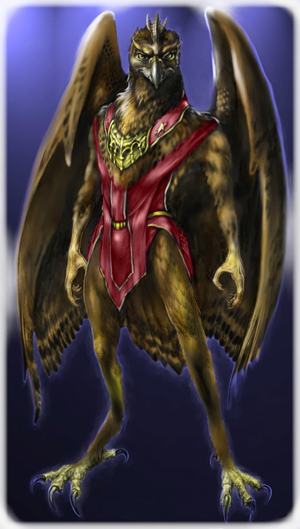
the team neared the strange building housing the missing artifact, Tchar was "abducted" by creatures evidently native to the mad planet. When the team gained entry to the building, he reappeared and challenged the remaining members of the party to honorable combat. He could not allow them to live, but was impressed by their skill in reaching the artifact. He disabled the internal gravity so that his ability to fly would not give him undue advantage. Kirk and Spock, experts in zero-gravity combat, were able to defeat him.
When the party returned to the Vedala asteroid, Tchar was remanded to the custody of the Vedala, who promised to cure him of his madness. (TAS: "The Jihad")
High King Kamuth[edit]
Kamuth is the Current high King of Skoria. He holds absolute power and is a strong ally of the United Federation of Planets.
Prince Dralar[edit]
Dralar is the 45th son of the High King Kamuth; as such he is in the direct line of succession (45th) . He is the Hirad'ja of the capital City of Siradran on Skoria. he is responsible for the building and Maintenance of a Starfleet preparatory Academy there, in the hopes of forging an even tighter alliance between the UFP and the Skorr Hierarchy. Dralar also bears the honor of being the Keeper of the Great Sky Key of Harridan, as such he is entitled to undertake the Ritual of Ahk'kan. he has served in the Skorr Royal Navy at the rank of Fleet Master. He has participated in Military campaigns against the following quadrant powers:
For Skoria
- Skorr - Borg Conflict (2399-2400)
- Skorr - Borg Conflict (2400-2401)
- Romulan Skorr Conflict (2402-2404)
- Orion Syndicate Conflicts (2406-2407)
For the 52nd Fleet
- Battle of Sector 001 (Late 2407)
Drola[edit]
Drola was the First Skorr astronaut to leave the atmosphere of Skoria in 2105. She made two complete orbits around the planet before returning safely. She is credited with ensuring the Skorr people are a space faring species. She is highly revered among explorers and scientists.
